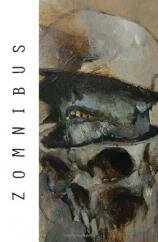Zomnibus
Review
Zomnibus
Is anyone getting really sick of zombies?
Me neither. Which is odd, because they’ve seemingly pervaded every last bit of our culture in the last few years—especially if you’re one who reads comics and plays video games—to a degree that we should all be getting sick of them.
We likely would be, too, if it weren’t for games like last year’s sequel to Left 4 Dead, comics like Robert Kirkman’s The Walking Dead, and films such asZombieland. Talented artists of various media continue to reinvent the way we experience the flesh-eating monstrosities, and it keeps us interested, no matter how much of an oversaturation the zombie market has sustained.
Zomnibus collects three of publisher IDW’s zombie offerings under one cover. The first two—Zombies!: Feast and Zombies!: Eclipse of the Dead—come from Sulaco Studios, while the third, Complete Zombies vs. Robots, is the unique vision of Chris Ryall and Ashley Wood. The stories collected in Zomnibus aren’t necessarily in the upper echelon of zombie fare, but they are entertaining enough to warrant an enjoyable read.
Feast is the most traditional zombie tale of the bunch. A few guards are transporting a bus full of inmates when the zombie apocalypse breaks out. The bus is turned over, and the guards must try to escort the inmates across the land of the dead. Writer Shane McCarthy immediately digs in, as the guards are faced with a child zombie. In another interesting point, one of the inmates turns while the rest are still shackled to him.
The story stays strong throughout, with a good ending, but there’s a major disappointment that comes with Feast too, and that’s the changing of the guard with the artists between chapters 2 and 3. The first two chapters are fantastically drawn and colored, with detailed and realistic art featuring caricatured expressions. It helps build the fear, and gore comes in graphic detail. There’s a very clear point in the story when someone else takes over, though, and things go seriously awry. Characters start to change proportions from page to page, and faces look dramatically different from one panel to the next. It’s so much of a distraction that getting through the rest of the story is difficult.
Eclipse of the Dead is the best story of the bunch, stays strong until the end, and features some solid art from Yair Herrera. He strikes a balance of focusing on detail when there’s a need for great emotion, while moving out to show the large picture when it’s most needed, with some great panel construction along the way.
The story deals with the people camping in an open-air stadium awhile after the start of the zombie apocalypse. Society, with all its vices, has somehow found a way in the confines during such treacherous times. Red Cross workers try to help people in need, but brutal gangs are on a reign of terror inside, even as the living dead scratch just outside the gates. Worse for the do-gooder occupants inside, the military is about to pull out, overwhelmed by the never-ending onslaught. As things get grim, a battle unfolds between the factions, as well as humans who decide to stand and fight against the zombies to help others flee.
Finally, Complete Zombies vs. Robots is the most original vision of the bunch, with absolutely fantastic art by Wood – sort of a pencil sketch meets an oddly impressionistic coloring style. Unfortunately, before all is said and done, the series goes completely off the hinges, from incredibly witty to hard to read.
Zombies vs. Robots starts with a group of arrogant scientists trying to one-up each other, going through a portal to the future…and then they die one by one. In the future, humanity is all but lost. There is a sole infant survivor who is being protected by autonomous robots until they can clone it and bring humanity back to power—why they would do so, even some among their ranks question.
At odds with this goal are the zombies, who collectively understand such a child to be their absolute last food source, and if they were to discover its existence, they would carry out a major attack on the robot base to get that meal. Of course, Murphy’s Law plays out, and everything that can go wrong does go wrong in the first chapters of the series. A doofus robot brings zombies back to the base just when the child happens to be in the open. A battle ensues, and the child gets a single drop of blood in its mouth. There goes humanity. Adding to this, the robots are also stained by the blood, which is explained turns to a computer virus in the robot world. Because they are all connected, it sets in motion the destruction of the robot race.
Ryall’s work is witty to start, and then he does an incredible job of methodically stripping away every last form of hope, piece by piece. It’s a rather brilliant story, but leaves him absolutely nowhere to go with it. But then he tries, and the stories that follow see him working way too hard to keep things going, bringing in the likes of Amazons and stretching the series well beyond its limits. No matter, the beginning is at least still a fun read.
Zomnibus also features an art gallery at the end, collecting a lot of very good full-page pieces by the artists included in this book. The stories contained definitely have their problems, but that doesn’t prevent Zomnibus on the whole from being the next entertaining fix for zombie enthusiasts who just can’t get enough.
Reviewed by William Jones on September 15, 2009
Zomnibus
- Publication Date: September 15, 2009
- Genres: Graphic Novel
- Paperback: 380 pages
- Publisher: IDW Publishing
- ISBN-10: 1600105270
- ISBN-13: 9781600105272








